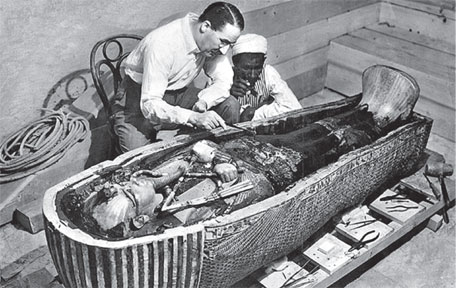The glory of the ancient Egyptians
By Amal HEWAVISSENTI
Undoubtedly, Egypt must be proud of her ancient glory. Ancient Egypt
developed along the River Nile around 5,000 years back and over the next
2,500 years, it grew into one of the greatest civilisations of all time.
The ancient Egyptians chose to dwell by the River Nile in Africa because
the river flooded annually spreading mud over the banks and thereby
creating ideal fertile land for agricultural pursuits.
Kingship
|

Opening of Tutankhaman's sarcophagus |
Egypt became a single kingdom in about 3100 BC and this places it
foremost among the most ancient states in the world. Conquests of other
countries and establishment of a vast empire made Egyptians globally
famous and their surprising capacity to farm a desert land is highly
appreciated. The Egyptian empire declined in 30 BC when Romans extended
their imperial authority on Egypt and made it a part of Roman empire.
The Pharaohs, the supreme rulers of Egypt were the gods after death
and the high priests of the Egyptians. Moreover, the Pharaoh was
considered to be the chief judge and also the commander-in-chief of the
army. A large number of officials, probably the relatives of Pharaoh,
was appointed by the king himself to steer the government. These
specially appointed officials were chiefly responsible for the proper
functioning of government departments such as the foreign affairs, the
civil service, public records and treasury. The Pharaohs were the symbol
of power and supreme kingship. Ordinary Egyptians worked on the land as
farmers and some hunted animals such as deer. Some of the ordinary
Egyptians fished and trapped animals sometimes just for sport.
The well known tomb cut into rock is that of Tutan Khamun in the
famous valley of kings. In pyramids, the actual burial place was reached
by a long passage carefully blocked and hidden from tomb robbers. The
pyramids were built close to the river Nile, so that massive stone
blocks could be transported to the building site by boat and moved on
sledges. Here the body of Pharaoh to be buried also arrived by boat. The
"Nilometers" exhibit the exceptional engineering expertise of early
Egyptians. They built special nilometers to measure the height of the
flood waters in July, to work out how much water they could use when
ploughing began in October. The ancient Egyptians employed papyrus reeds
to make boats, shoes, and writing paper. Papyrus scrulls preserve
ancient Egyptians hieroglyphic writing which could be translated today.
They used papyrus to write on and for painting hieroglyphs for their
writing.
Mummification
As ancient Egyptians firmly believed in life after death, their
bodies were mummified to prevent decay and it took almost seventy days
to mummify a body. The body was preserved in salt for forty days to dry.
Before being bandaged, the dried body was rubbed with oils and spices
and the heart was placed inside. When the body was completely dry it was
wrapped in linen bandages and was sealed inside a coffin.
Most of the internal organs were placed in canopy jars. The
falcon-headed canopy jar held the intestines while the jackal headed
canopy jar held the stomach. Amulets were wrapped into the bandages to
ward off any force of evil.
The sun-god Ra and Osiris the god of the dead were the most prominent
gods worshipped by them. When kings and queens died, they were placed in
tombs together with possibly necessary things for the next world, such
as food, jewels, shabtis and other possessions that they intensely loved
when they were alive. Most royal tombs were later robbed but the tomb of
the boy Pharaoh Tutankhaman was found in 1922 with most of its treasures
untouched.
The Egyptians thought that the dead person made a journey to the next
world and continued to live the same type of life there.
The king would still be a king and a farm labourer would still be a
farm labourer.
Famous figures
Cleopatra, the ancient Egypt's most famous queen, succeeded in
holding onto power for many years before she died stung by a poisonous
snake. On her father's death in 51 BC. Cleopatra ruled Egypt with her
younger brother Ptolemy.
However at this time, expanding Roman empire was slowly invading
Egypt and she was ousted by Romans. She was soon restored to power by
Julius Caesar who allowed her to rule Egypt with another of her
brothers.
Meanwhile, Mark Antony having made his base in the capital of Egypt,
Alexandria permitted Cleopatra and her son Caesorion to be joint rulers
of Egypt and Cyprus.
However, civil war broke out again in the Roman empire in 31 BC and
Antony and Cleopatra were defeated at the battle of Actium by Octavius.
They both committed suicide rather than be taken prisoner. Tutankhaman
(about 1370 - 1352 BC) is one of the best known of all the Egyptian
kings. However, the exact reason for his sudden death is still shrouded
in mystery. His fame is based mainly on the amazing treasures found
inside his tomb when it was discovered in 1922.
The treasure includes solid gold coffin, jewellery, a throne,
weapons, chariots and a celebrated gold funeral mask which shows what
the young king actually looked like. The Egyptian empire came to an end
in 30 BC when the Romans invaded and Egypt became part of the Roman
empire. |

